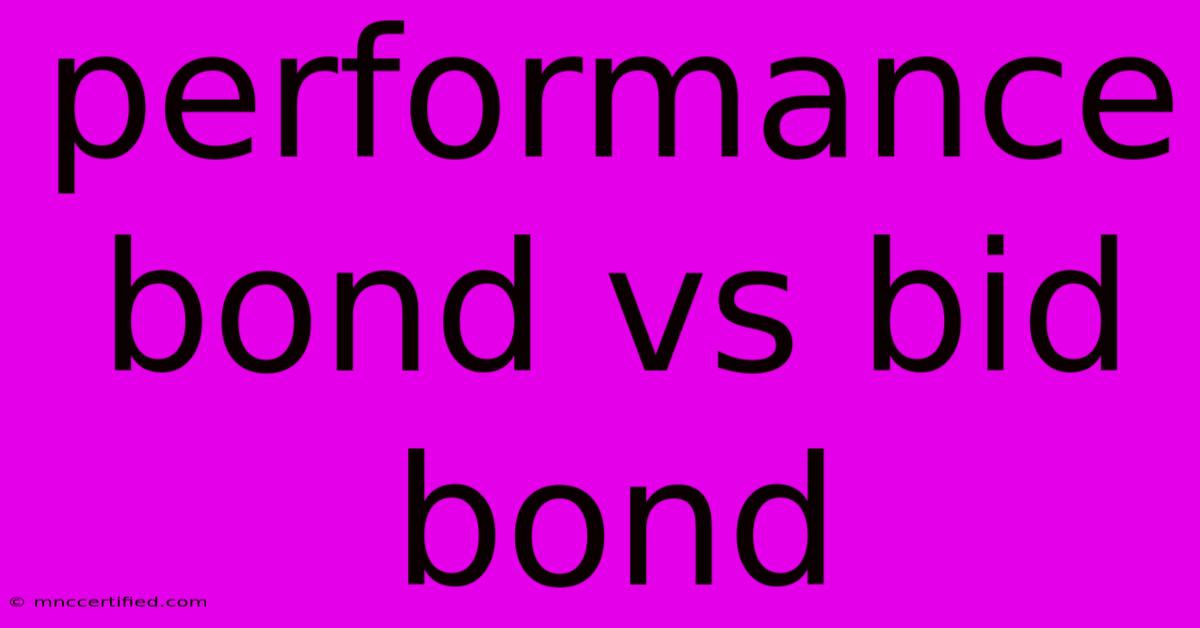Performance Bond Vs Bid Bond

Table of Contents
Performance Bond vs. Bid Bond: Understanding the Key Differences
Choosing between a performance bond and a bid bond can be confusing, especially for those new to the world of construction and contracting. Both are crucial in securing projects, but they serve vastly different purposes and offer distinct levels of protection. This comprehensive guide will clarify the key differences between performance bonds and bid bonds, helping you understand which is right for your situation.
What is a Bid Bond?
A bid bond is a type of surety bond that guarantees a contractor's commitment to a project. It's essentially a promise to the project owner that the contractor will enter into a contract if their bid is accepted. The bid bond protects the owner from losing time and money if the winning bidder backs out after the bid is accepted. Think of it as insurance for the owner against a potentially unreliable bidder.
Key Features of a Bid Bond:
- Protects the owner: Ensures the winning bidder will sign the contract.
- Small percentage of the bid amount: Typically ranges from 5% to 10% of the total bid.
- Temporary coverage: Expires once the contract is signed or the bid is rejected.
- Guarantees good faith: Shows the owner that the bidder is serious and financially stable enough to undertake the project.
- Often required for large projects: Especially those funded by government entities or large corporations.
What Happens if the Bidder Defaults?
If the winning bidder fails to sign the contract, the surety company (the insurer) pays the owner the difference between the winning bid and the next lowest bid. This compensates the owner for the time lost in finding a replacement contractor and ensures the project remains on schedule.
What is a Performance Bond?
A performance bond, unlike a bid bond, guarantees that a contractor will complete the project according to the specifications outlined in the contract. It's a form of insurance for the owner, protecting them from financial losses if the contractor fails to perform their contractual obligations. It ensures the project gets finished as promised.
Key Features of a Performance Bond:
- Protects the owner: Guarantees project completion as per the contract terms.
- Larger percentage of the contract amount: Typically ranges from 10% to 50% of the total contract value. This percentage depends on factors such as project complexity and contractor's history.
- Coverage throughout the project: Remains active until the project is completed and accepted by the owner.
- Guarantees project completion: Protects the owner from financial losses due to contractor default.
- Crucial for substantial projects: Provides significant security for larger, more complex undertakings.
What Happens if the Contractor Defaults?
If the contractor fails to complete the project as agreed, the surety company steps in. They either find a replacement contractor to finish the job or pay the owner directly to cover the costs of completion and any resulting damages.
Performance Bond vs. Bid Bond: A Comparison Table
| Feature | Bid Bond | Performance Bond |
|---|---|---|
| Purpose | Guarantees contract execution | Guarantees project completion |
| Timing | Before contract signing | After contract signing |
| Coverage | Until contract is signed or bid rejected | Until project completion and acceptance |
| Amount | 5-10% of bid amount | 10-50% of contract amount |
| Protects | Owner from defaulting bidder | Owner from defaulting contractor |
Choosing the Right Bond
Understanding the differences between performance and bid bonds is critical for all parties involved in a construction project. The bid bond ensures a contractor's commitment to the project before it even begins, while the performance bond safeguards the project's completion after the contract has been signed. Both bonds are essential tools for managing risk and ensuring successful project delivery. Consult with a surety bond specialist to determine the appropriate bonds for your specific project needs.
Off-Page SEO Considerations:
To further boost the SEO of this article, consider the following off-page strategies:
- Link building: Reach out to relevant construction blogs and websites and request links to this article.
- Social media promotion: Share the article on relevant social media platforms like LinkedIn, Twitter, and Facebook.
- Guest blogging: Write guest posts on other relevant websites, including a link back to this article.
- Directory submissions: List your article in relevant online directories.
By implementing both on-page and off-page SEO strategies, you can significantly increase the visibility of this article and attract a wider audience. Remember to consistently update and improve your content to stay ahead of the competition.

Thank you for visiting our website wich cover about Performance Bond Vs Bid Bond. We hope the information provided has been useful to you. Feel free to contact us if you have any questions or need further assistance. See you next time and dont miss to bookmark.
Featured Posts
-
Brothers Bond Bourbon Signed
Nov 30, 2024
-
10 Bond St New York Ny 10012
Nov 30, 2024
-
Air Pods Pro 2 Lowest Price Yet
Nov 30, 2024
-
Allen Steinfeld Engagement Post Chiefs Win
Nov 30, 2024
-
Swift Kelce At Chiefs Raiders Game
Nov 30, 2024